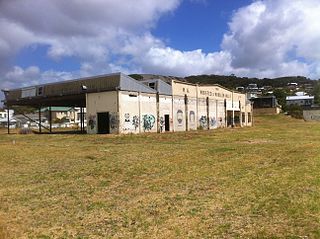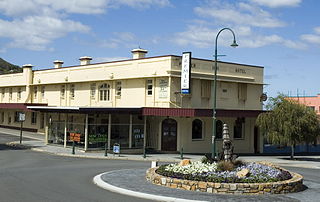
Milton is an inner suburb of the City of Brisbane, Queensland, Australia.

Ipswich is an urban region in South East Queensland, Australia, which is located in the south-west of the Brisbane metropolitan area. Situated on the Bremer River, it is approximately 40 kilometres (25 mi) west of the Brisbane CBD. A local government area, the City of Ipswich has a population of 200,000. The city is renowned for its architectural, natural and cultural heritage. Ipswich preserves and operates from many of its historical buildings, with more than 6000 heritage-listed sites and over 500 parks. Ipswich began in 1827 as a mining settlement.

A coffee palace was an often large and elaborate residential hotel that did not serve alcohol, most of which were built in Australia in the late 19th century.

Kilkivan is a town and locality in the Gympie Region of Queensland, Australia. At the 2016 census, Kilkivan had a population of 713. Rossmore is a neighbourhood within the locality to the south-west of the town of Kilkivan.

Bulimba is a suburb in the City of Brisbane, Queensland, Australia. It is located 4 kilometres (2.5 mi) north-east of the CBD, on the southern bank of the Brisbane River, and borders Balmoral, East Brisbane, Hawthorne, and Morningside. The 2011 Australian Census recorded a population of 5,941 increasing rapidly to 6,843 in 2016.

The Town of Albany was a local government area in the Great Southern region of Western Australia representing the town of Albany, 410 km south-southeast of the capital, Perth.

Thundelarra is a conservation reserve that was previously run as a pastoral lease in Western Australia, located 70 kilometres (43 mi) south east of Yalgoo and 160 kilometres (99 mi) north of Dalwallinu in the Murchison region.

Albany Woollen Mills, also known as the Western Australian Worsted and Woollen Mills Ltd., was a woollen mill located in Albany, Western Australia.

The Esplanade Hotel was a hotel that once stood overlooking Middleton Beach in Albany, Western Australia. The hotel was demolished in January 2007 by Singaporean owners, WCP Plaza, to make way for an 81-room hotel, function centre, village square, shops and health and recreation facilities. The proposal for the new hotel was approved in 2007 by the City of Albany. The Council also supported the rezoning of several locations in Earl Street and Barry Court to allow the development of the hotel. The site remains vacant in 2015.

The Rocks, also referred to as Government House or Government Cottage, is a residence in Albany in the Great Southern region of Western Australia.

Peedamulla Station, often referred to as Peedamulla, is a pastoral lease that currently operates as a cattle station but once operated as a sheep station.

William Grills Knight was a prominent businessman and politician who served as the Mayor of Albany in the Great Southern region of Western Australia.

John Moir was prominent businessman and politician who served as the Mayor of Albany in the Great Southern region of Western Australia.

Robert Andrew Muir was a merchant and politician who served as the mayor of Albany, Western Australia.

John Moir was a settler and pastoralist in the areas to the east of Albany, in the Great Southern region of Western Australia.

Stirling Terrace, Albany is a street in the centre of Albany, Western Australia adjoining York Street.

White Star Hotel is a heritage listed building that operates as a hotel in Albany in the Great Southern region of Western Australia. The hotel is located adjacent to the Royal George Hotel on Stirling Terrace, once the commercial and social centre of town, overlooking Princess Royal Harbour. The building was named for the White Star Line, an important shipping and passenger line that once operated out of Albany.

The London Hotel is a hotel located on Stirling Terrace overlooking Princess Royal Harbour in Albany in the Great Southern region of Western Australia.

The Premier Hotel is a hotel and a heritage listed building located on the corner of York Street and Grey Street, opposite the Albany Town Hall, in Albany in the Great Southern region of Western Australia.





















